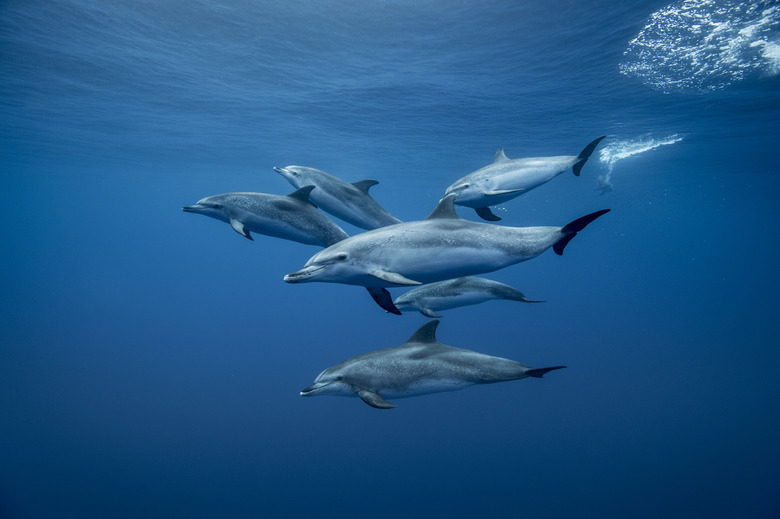The Difference Between Dolphin Fish & Dolphin Mammal
Dolphin fish and dolphins make their home in the same tropical and subtropical waters of the Atlantic, Pacific and Indian Oceans. They are large, predatory, fast-swimming ocean-dwellers. However, that's where the similarities end. Dolphins are more closely related to humans than dolphinfish. Dolphins aren't fished commercially, but dolphinfish are fished extensively and are an important food source in many parts of the world. Dolphinfish are known for their colorful blue, yellow and green scales but dolphins are typically dull shades of gray. While they may have similar body shapes and habitats, their life history is quite different.
TL;DR (Too Long; Didn't Read)
**TL;DR (Too Long; Didn't Read)**
Dolphins are mammals and closely related to whales and other marine mammals. Dolphinfish belong to the class of bony fishes.
A Dolphin Fish by Any Other Name
A Dolphin Fish by Any Other Name
The dolphinfish is a fish of many names. There are only two species of dolphinfish: the common dolphinfish, Coryphaena hippurus and the pompano dolphin, Coryphaena equiselis. Dolphinfish are also called by their Spanish name, dorado fish. Their vibrant green color earned them another moniker: green dolphin. In fish markets and restaurants, they go by the name mahi mahi. The common dolphinfish and the pompano dolphin are only distinguished from each other by size and the location of a tooth patch.
Is a Dolphin a Fish?
Is a Dolphin a Fish?
Despite living their entire lives in the ocean, dolphins are not fish. Dolphinfish and dolphins belong to different classes in the animal kingdom. Dolphins, like other mammals, are warm blooded, use lungs to breathe air, have a small amount of hair and give birth to live offspring that drink milk from their mothers. Dolphinfish are members of the class of bony fishes and dolphins belong to the class of mammals. Dolphinfish are cold blooded, breathe underwater with gills, have scales covering their skin and reproduce by laying eggs. Dolphins and dolphinfish share some traits, such as body shape, due to convergent evolution. Convergent evolution is a process where two distantly related groups of organisms develop similar physical traits over time by living in the same environment.
Lifespan and Growth
Lifespan and Growth
Like other large mammals, dolphins can live for many years. The common bottlenose dolphin, one of the many species of dolphins throughout the world, has a typical lifespan of more than 40 years. Juvenile dolphins stay with their mothers for three to six years, following a 12-month gestation period. Females typically birth one calf at a time. They reach full maturity between five and 15 years of age.
Dolphinfish have a more accelerated growth rate. They reach full maturity four to five months after hatching and live only about two to four years. Females spawn, or lay eggs, several times per year. Larvae are tiny when they hatch, only about one-eighth of an inch long. They quadruple in size in the first two weeks of life and grow about 5 inches per month.
Feeding Habits
Feeding Habits
Both dolphins and dolphinfish are effective predators, but they prey on different kinds of organisms. Bottlenose dolphins hunt for fish, squids and shellfish such as crabs and shrimp. They often work together to herd their prey into one location. Dolphins also can produce high-frequency sounds to find prey by echolocation. Dolphinfish feed mainly smaller fish, such as trigger fish and puffer fish. They also prey on juveniles of larger fish such as tuna and mackerel. Dolphinfish rely on their keen eyesight and lateral line sensory system to find prey.
Cite This Article
MLA
Mentzer, A.P.. "The Difference Between Dolphin Fish & Dolphin Mammal" sciencing.com, https://www.sciencing.com/difference-dolphin-fish-dolphin-mammal-8393806/. 22 November 2019.
APA
Mentzer, A.P.. (2019, November 22). The Difference Between Dolphin Fish & Dolphin Mammal. sciencing.com. Retrieved from https://www.sciencing.com/difference-dolphin-fish-dolphin-mammal-8393806/
Chicago
Mentzer, A.P.. The Difference Between Dolphin Fish & Dolphin Mammal last modified March 24, 2022. https://www.sciencing.com/difference-dolphin-fish-dolphin-mammal-8393806/
